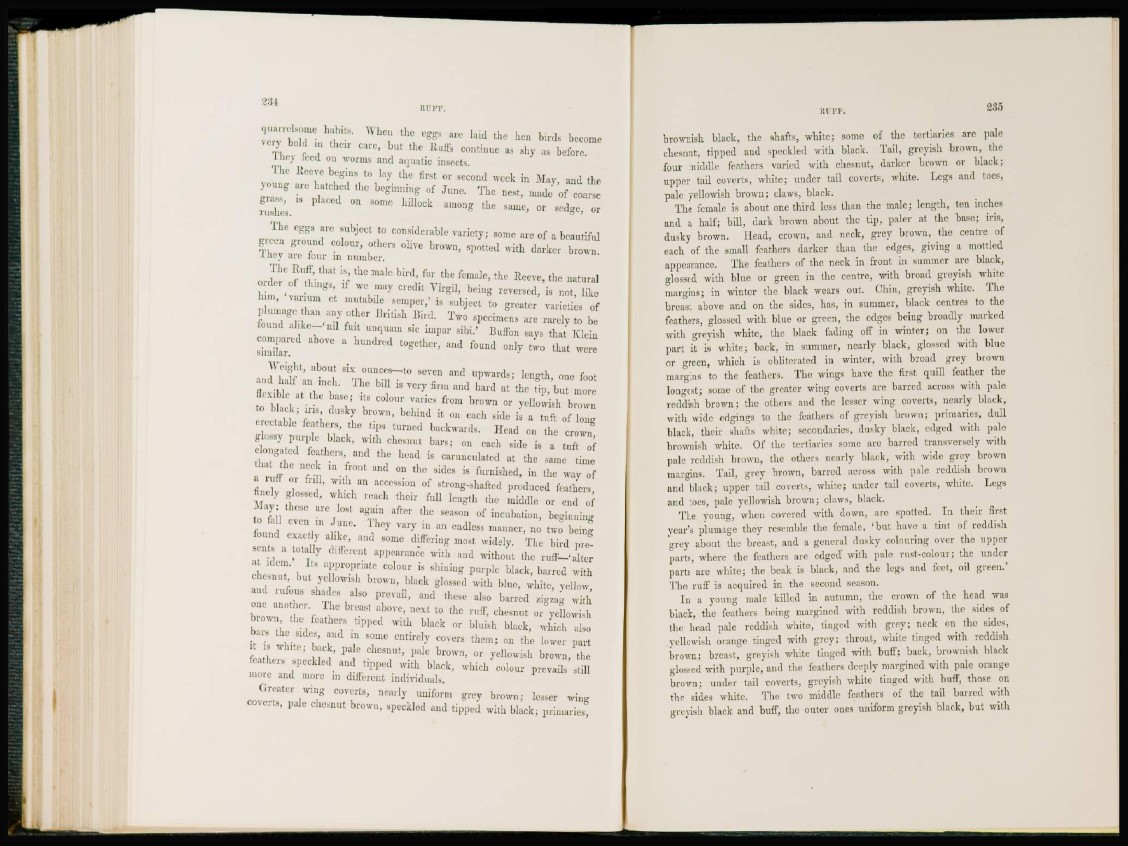
RUFF.
quarrelsome habits. When the eggs are hud the hen birds become
very bold in their care, but the Ruffs continue as shy as before.
They feed on worms and aquatic insects.
The Reeve begins to lay the first or second week in Slay, and the
young are hatched the beginning of June. The nest, made of coarse
grass, is placed on some hillock among the same, or sedge, or
rushes.
The eggs are subject to considerable variety; some arc of a beautiful
green ground colour, others olive brown, spotted with darker brown.
They are four in number.
The Ruff, that is, t h e male bird, for the female, the Reeve, the natural
order of things, if we may credit Virgil, being reversed, is not, like
him, ' v a r i um et mutabile semper,' is subject to greater varieties of
plumage than any other British Bird. Two specimens are rarely to be
found alike—'nil fuit unquam sic impar sibi.' Buffon says that Klein
compared above a hundred together, and found only two that were
similar.
Weight, about six ounces—to seven and upwards; length, one foot
and half an inch. The bill is very firm and hard at the tip, b u t more
flexible at the base; its colour varies from brown or yellowish brown
to black; iris, dusky brown, behind it on each side is a tuft of long
erect able feathers, the tips turned backwards. Head on the crown,
glossy purple black, with chesnut bars; on each side is a tuft of
elongated feathers, and the head is carunculated at the same time
that the neck in front and on the sides is furnished, in the way of
a ruff or frill, with an accession of strong-shafted produced feathers,
finely glossed, which reach their full length the middle or end of
-May: these are lost again after the season of incubation, beginning
to fall even in June. They vary in an endless manner, no two being
found exactly alike, and some differing most widely. The bird presents
a totally different appearance with and without the raff—'alter
at idem.* Its appropriate colour is shining purple black, barred with
chesnut, but yellowish brown, black glossed with blue, white, yellow,
and rufous shades also prevail, and these also barred zigzag with
one another. The breast above, next to the ruff, chesnut or yellowish
brown, the feathers lipped with black or bluish black, which also
bars the sides, and in sonic entirely covers them; on the lower part
it is white; back, pale chesnut, pale brown, or yellowish brown, the
feathers speckled and tipped with black, which colour prevails still
more and more in different individuals.
Greater wing coverts, nearly uniform grey brown; lesser wing
coverts, pale chesnut brown, speckled and tipped with black; primaries,
RUFF. 235
brownish black, the shafts, white; some of the tertiaries are pale
chesnut, tipped and speckled with black. Tail, greyish brown, the
four middle feathers varied with chesnut, darker brown or black;
upper tail coverts, white; under tail coverts, white. Legs and toes,
pale yellowish brown; claws, black.
The female is about one third less than the male; length, ten inches
and a half; biU, dark brown about the tip, paler at the base; iris,
dusky brown. Head, crown, and neck, grey brown, the centre of
each of the small feathers darker than the edges, giving a mottled
appearance. The feathers of the neck in front in summer are black,
glossed with blue or green in the centre, with broad greyish white
margins; in winter the black wears out. Chin, greyish white. The
breast above and on the sides, has, in summer, black centres to the
feathers, glossed with blue or green, the edges being broadly marked
with greyish white, the black fading off in winter; on the lower
part it is white; back, in summer, nearly black, glossed with blue
or green, which is obliterated in winter, with broad grey brown
margins to the feathers. The wings have the first quill feather the
longest; some of the greater wing coverts are barred across with pale
reddish brown; the others and the lesser wing coverts, nearly black,
with wide edgings to the feathers of greyish brown; primaries, dull
black, their shafts white; secondaries, dusky black, edged with pale
brownish white. Of the tertiaries some are barred transversely with
pale reddish brown, the others nearly black, with wide grey brown
margins. Tail, grey brown, barred across with pale reddish brown
and black; upper tail coverts, white; under tail coverts, white. Legs
and toes, pale yellowish brown; claws, black.
The young, when covered with down, are spotted. In their first
year's plumage they resemble the female, ' b u t have a tint of reddish
grey about the breast, and a general dusky colouring over the upper
parts, where the feathers are edged with pale rust-colour; the under
parts arc white; the beak is black, and the legs and feet, oil green.'
The ruff is acquired in the second season.
In a young male killed in autumn, the crown of the head was
biack, the feathers being margined with reddish brown, the sides of
the head pale reddish wdiite, tinged with grey; neck on the sides,
.yellowish orange tinged with grey; throat, wdiite tinged with reddish
brown; breast, greyish white tinged with buff; back, brownish black
glossed with purple, and the feathers deeply margined with pale orange
brown; under tail coverts, greyish white tinged with buff, those on
the sides white. The two middle feathers of the tail barred with
greyish black and buff, the outer ones uniform greyish black, but with